Kenneth C. Davis's Blog, page 75
August 31, 2015
Sat 9/5 at Decatur Book Festival THE HIDDEN HISTORY OF AMERICA AT WAR-Speaking Calendar
List of Upcoming Speaking Engagements:
September 5 The Atlanta Journal Constitution Decatur Book Festival 11:15 AM
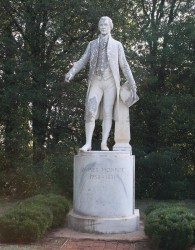
Statue of President James Monroe in the Garden at Ash Lawn-Highland
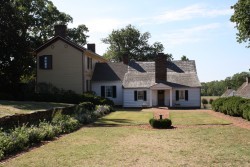
Ash Lawn-Highland Home of President James Monroe
September 13 Ash Lawn-Highland (Home of President James Monroe) 1-3 PM
THIS IS A FAMILY FRIENDLY EVENT CELEBRATING NATIONAL LITERACY MONTH. Ash Lawn-Highland is located a short distance from Thomas Jefferson’s Monticello.
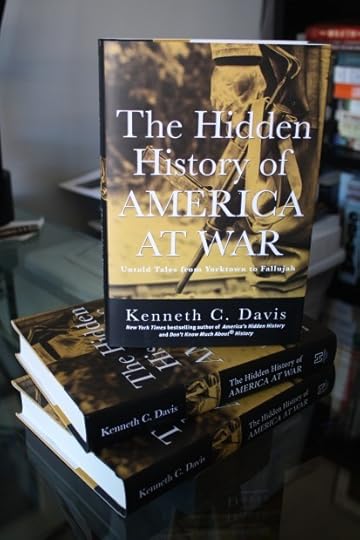
THE HIDDEN HISTORY OF AMERICA AT WAR: Untold Tales from Yorktown to Fallujah (May 5-Hachette Books/Random House Audio)
Pop Quiz: Which President signed Labor Day into law?
(Repost of a 2011 videoblog, directed, edited and produced by Colin Davis)
Answer: Labor Day was signed into law by Grover Cleveland in 1894
The end of summer, a three-day weekend, burgers on the grill, and a back-to-school shopping spree, right? And the most important question, “Can I still wear white?”
But very few people associate Labor Day with a turbulent time in American History. That’s what Labor Day is really about. The holiday was born during the violent union-busting days of the late 19th century, when sweat shop conditions killed children, when there was no minimum wage and when going on vacation meant you were out of work.
If you like holidays, benefits and a five-day, 40-hour work week, you need to know about Labor Day.
When Labor Day was signed into law by Grover Cleveland in 1894, it was a bone tossed to the labor movement. And it was deliberately placed in September to ensure that it would not recall the memory of the deadly rioting at Chicago’s Haymarket Square in May 1886. Europe’s workers, and later the Communist Party, adopted May Day as a worker’s holiday to commemorate the deadly Haymarket Sqaure Riot which came about during a strike against thee McCormack Reaper Company.
Although Labor Day did become federal law in 1894, most of labor’s successes –the minimum wage, overtime, the end of child labor – did not come about until the Depression-era reforms of the New Deal.
Labor Day was created to celebrate the “strength and spirit of the American worker.” But this holiday should remind us that — like so many things we take for granted — those victories for working people came at great cost, in blood, sweat and tears.
For more on the history of Haymarket Square, here is a link to the Chicago Historical Society’s web project.
“American Experience,” the PBS documentary series, produced a Homestead Strike piece as part of its film about Andrew Carnegie.
You can read more about the history of the trade union movement in Don’t Know Much About History: Anniversary Edition and Don’t Know Much About® the American Presidents.

Don’t Know Much About® the American Presidents (Hyperion Paperback-April 15, 2014)
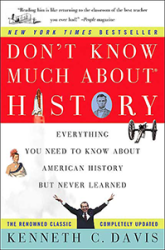
Don’t Know Much About® History: Anniversary Edition (Harper Perennial and Random House Audio)
August 27, 2015
Don’t Know Much About® Lyndon B. Johnson
(Repost of 2013 essay)

Lyndon B. Johnson (March 1964)
(Photo: Arnold Newman, White House Press Office)
All I have I would have given gladly not to be standing here today.
Lyndon B. Johnson, in his first address as President to a joint session of Congress (November 27, 1963)
The 36th President, Lyndon B. Johnson, was born on August 27, 1908, in a small farmhouse near Stonewall, Texas on the Pedernales River. Coincidentally, it is also the date on which LBJ accepted the 1964 Democratic nomination for President. (Senator Hubert H. Humphrey was his Vice Presidential nominee.)
In some respects, history and time have been kinder to Lyndon B. Johnson than his tortured Presidency –and certainly the critics of his day—would have possibly suggested. A power broker extraordinaire during his days in Congress, especially during his twelve years in the Senate, Lyndon B. Johnson challenged John F. Kennedy for the Democratic nomination in the 1960 primaries, and then accepted Kennedy’s offer to become his Vice Presidential running mate. Johnson was credited with helping Kennedy win Southern votes and ultimately the election.
On November 22, 1963, history and America changed with Kennedy’s assassination. Johnson became President, taking the oath of office aboard Air Force One with Jacqueline Kennedy, the dead President’s widow standing beside him.
Driven by a rousing sense of social justice, born out of his youth and upbringing in hardscrabble Texas and Depression-era experiences, he had become one of Franklin D. Roosevelt’s most loyal New Dealers. First in a federal job, then in Congress and later as “Master of the Senate.” As President, Johnson set the country on a quest for what he called the “Great Society,” looking for ways to end the great economic injustice and bitter racial disparity that existed in America in 1963. But his vision for a “Great Society” was counterbalanced, and ultimately overshadowed by his doomed course in pursuing the war in Vietnam.
In the midst of the war, recently released White House tapes reveal Johnson confided–
I can’t win and I can’t get out.
Fast Facts-
•Johnson was the first Congressman to enlist for duty after Pearl Harbor.
•Johnson was the fourth president to come into office upon the death of a president by assassination. (The others were Andrew Johnson after Lincoln, Chester A. Arthur after Garfield, and Theodore Roosevelt after McKinley.)
•Johnson appointed the first black Supreme Curt Justice, Thurgood Marshall.
The Johnson Library and Museum is in Austin, Texas. Lyndon B. Johnson died at the age of 67 on January 22, 1973. His New York Times obituary.
Read more about Lyndon B. Johnson, his presidency and the Vietnam War and civil rights movement in Don’t Know Much About® the American Presidents and Don’t Know Much About® History.
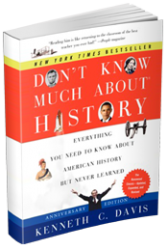
Don’t Know Much About History (Revised, Expanded and Updated Edition)
[image error]
Don’t Know Much About the American Presidents
(September 18, 2012-Hyperion Books)
August 20, 2015
Don’t Know Much About the 14th Amendment
Since the 14 th Amendment is back in the news because of some Republican candidates’ views about its use and interpretation, I thought it would be useful to repost this.
(The original post of this piece is from July 2010 and was revised last year.)
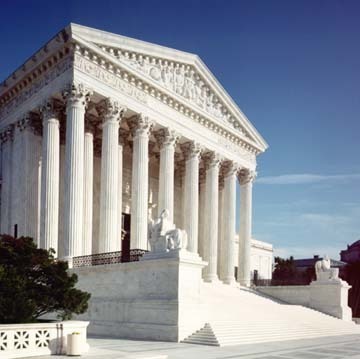
Image Source: Supreme Court of the United States
On July 9, 1868, the states of Louisiana and South Carolina ratified the 14th Amendment to the U.S. Constitution, providing the necessary three-fourths of the states to adopt this very significant Amendment as part of the law of the land.
One of the “Reconstruction Amendments” ratified in the wake of the Civil War, it had far-reaching consequences in American history, touching on every aspect of public and private life in America — from the schoolroom to the bedroom. And it still does. Think of a controversial court decision in our history and chances are the 14th Amendment is involved. It has been invoked in such major decisions as Brown v. Board of Education in 1954, which ended segregation of public schools; Roe v. Wade (1973), which disallowed most existing restrictions on abortion; and Loving v. Virginia (1967), which ended race-based restrictions on marriage in America. It also provided the Constitutional authority for many of the most important pieces of civil rights legislation passed in the 1960s. And the 14th Amendment has been central to the same-sex marriage debate. Here is an article from the National Constitution Center on 10 Supreme Court Cases about the 14th Amendment. The first two sections of the Amendment read as follows. The full text of the 14th Amendment can be found at the links to the National Archives and Library of Congress at the bottom of this post.
AMENDMENT XIV Passed by Congress June 13, 1866. Ratified July 9, 1868. Section 1. All persons born or naturalized in the United States, and subject to the jurisdiction thereof, are citizens of the United States and of the State wherein they reside. No State shall make or enforce any law which shall abridge the privileges or immunities of citizens of the United States; nor shall any State deprive any person of life, liberty, or property, without due process of law; nor deny to any person within its jurisdiction the equal protection of the laws. Section 2. Representatives shall be apportioned among the several States according to their respective numbers, counting the whole number of persons in each State, excluding Indians not taxed. But when the right to vote at any election for the choice of electors for President and Vice-President of the United States, Representatives in Congress, the Executive and Judicial officers of a State, or the members of the Legislature thereof, is denied to any of the male inhabitants of such State, being twenty-one years of age,* and citizens of the United States, or in any way abridged, except for participation in rebellion, or other crime, the basis of representation therein shall be reduced in the proportion which the number of such male citizens shall bear to the whole number of male citizens twenty-one years of age in such State. *Changed by section 1 of the 26th amendment.
Its immediate impact was to give citizenship to “all persons born or naturalized in the United States,” which included former slaves. Creating national citizenship that was independent of state citizenship, the 14th Amendment reversed the 1857 Dred Scott decision which denied citizenship to most slaves.
In addition, the 14th Amendment forbids states from denying any person “life, liberty or property, without due process of law” or to “deny to any person within its jurisdiction the equal protection of its laws.”
These clauses, usually referred to as “due process” and “equal protection,” have been involved in some of the most significant decisions in American history. You don’t need to be a Constitutional scholar to understand this Amendment and the profound impact it has had –and continues to have– on every American’s life.
Here is a link to the National Archives US Constitution site
Here is a link to more information on the 14th Amendment from the Library of Congress
And this link from the National Constitution Center has more on the history of Amendment XIV
August 10, 2015
Who Said It? (8/10/2015)
Answer: President Franklin D. Roosevelt- Statement on Signing the Social Security Act (August 14, 1935)
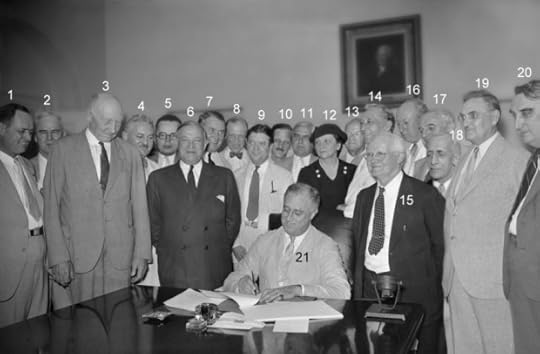
President Franklin D. Roosevelt, signing the Social Security Act (August 14, 1935) Photo Source and Key to Figures in photo: Social Security Administration website
Today a hope of many years’ standing is in large part fulfilled. The civilization of the past hundred years, with its startling industrial changes, has tended more and more to make life insecure. Young people have come to wonder what would be their lot when they came to old age. The man with a job has wondered how long the job would last.
This social security measure gives at least some protection to thirty millions of our citizens who will reap direct benefits through unemployment compensation, through old-age pensions and through increased services for the protection of children and the prevention of ill health.
We can never insure one hundred percent of the population against one hundred percent of the hazards and vicissitudes of life, but we have tried to frame a law which will give some measure of protection to the average citizen and to his family against the loss of a job and against poverty-ridden old age.
Source: “FDR’s Statements on Social Security”–Social Security Website
Don’t Know Much About® Herbert Hoover

“We are challenged with a peace-time choice between the American system of rugged individualism and a European philosophy of diametrically opposed doctrines— doctrines of paternalism and state socialism. . . . Our American experiment in human welfare has yielded a degree of well- being unparalleled in all the world. It has come nearer to the abolition of poverty, to the abolition of fear of want than humanity has ever reached before.” –Herbert Hoover, “Campaign Speech” (October 22, 1928)
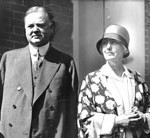
Herbert and Lou Henry Hoover in their Washington, DC home the morning after he was nominated to run for president (1928). (Courtesy: The Herbert Hoover Presidential Library & Museum)
Born on August 10, 1874, Herbert Clark Hoover, the 31st president of the United States. Herbert Hoover was born into a Quaker family in Iowa, and orphaned at nine. He went to live with relatives in Oregon. A college education at Stanford led to a career in the mining industry and a great personal fortune. You may know that he was the Republican president when the Stock Market crashed in 1929 and he attempted to lead the country through the first years of the Great Depression. Hoover was defeated by Democrat Franklin D. Roosevelt in 1932. But you may not know that Hoover was considered a hero and savior to millions of people. First during World War I, he had organized food relief programs in war-torn Belgium. Later, in the aftermath of World War I, Russia was in the throes of Europe’s greatest calamity since the days of the Black Plague . More than five million died in the new Soviet Russia when famine struck. In 1921, Herbert Hoover led America’s response to the “Great Famine,” subject of this PBS documentary and is credited with saving millions of lives. Hoover gets hard knocks for the hard times of the Depression and his flawed response to the problems confronting America. But others assess him more generously. Historian Richard Norton Smith once noted:
“Herbert Hoover saved more lives through his various relief efforts than all the dictators of the 20th century together could snuff out. Seventy years before politicians discovered children, he founded the American Child Health Association. The problem is, Hoover defies easy labeling. How can you categorize a ‘rugged individualist’ who once said, ‘The trouble with capitalism is capitalists; they’re too damn greedy.’ ” (“Remembering Herbert Hoover,” New York Times, August 10, 1992)
Some Fast Facts about Herbert Hoover:
✱ Hoover was the first president born west of the Mississippi.
✱ His wife, Lou, was the only female geology major at Stanford when they met. They later collaborated on a translation from Latin of a mining and metallurgy text, De Re Metallica, published in 1912. While they lived in China, the Hoovers lived through the 1900 Boxer Rebellion and both learned Chinese, and they sometimes spoke to each other in Chinese at the White House.
✱ Hoover’s inaugural in 1929 was the first to be recorded on talking newsreel.
✱ Hoover was the first of two Quaker presidents. (The other was Richard M. Nixon.)
President Hoover died on October 20, 1964 in New York City. He was 90 years old. This is his New York Times obituary. The Herbert Hoover Presidential Library & Museum offers archival materials and online exhibitions.
You can read more about Hoover in Don’t Know Much About® the American Presidents (Hyperion Books/Random House Audio)

Don’t Know Much About® the American Presidents (Hyperion Paperback-April 15, 2014)
August 7, 2015
Don’t Know Much About® the Tonkin Resolution
What was the Tonkin Resolution?
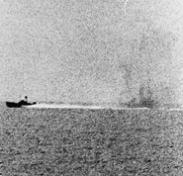
Photograph taken from USS Maddox (DD-731) during her engagement with three North Vietnamese motor torpedo boats in the Gulf of Tonkin, 2 August 1964. (Courtesy of the U.S. Naval Historical Cente)r
Fifty-one years ago, on August 7, 1964, Congress approved a resolution that soon became the legal rationalization for the Vietnam War. (New York Times story)
It came in August 1964 with a brief encounter in the Gulf of Tonkin, the waters off the coast of North Vietnam. where , the U.S. Navy posted warships loaded with electronic eavesdropping equipment enabling them to monitor North Vietnamese military operations and provide intelligence to CIA-trained South Vietnamese commandos. One of these ships, the U.S.S. Maddox was reportedly fired on by gunboats from North Vietnam.

Lyndon B. Johnson (March 1964)
(Photo: Arnold Newman, White House Press Office
Coming as it did in the midst of LBJ’s 1964 campaign against hawkish Republican Barry Goldwater, President Johnson felt the incident called for a tough response. Johnson had the Navy send the Maddox and a second destroyer, the Turner Joy, back into the Gulf of Tonkin. A radar man on the Turner Joy saw some blips, and that boat opened fire. On the Maddox, there were also reports of incoming torpedoes, and the Maddox began to fire. There was never any confirmation that either ship had actually been attacked. Later, the radar blips would be attributed to weather conditions and jittery nerves among the crew.
According to Stanley Karnow’s Vietnam: A History, “Even Johnson privately expressed doubts only a few days after the second attack supposedly took place, confiding to an aide, ‘Hell, those dumb stupid sailors were just shooting at flying fish.’”
Johnson ordered an air strike against North Vietnam and then called for passage of the Gulf of Tonkin Resolution. This legislation gave the president the authority to “take all necessary measures” to repel attacks against U.S. forces and to “prevent further aggression.” The resolution not only gave Johnson the powers he needed to increase American commitment to Vietnam, but allowed him to blunt Goldwater’s accusations that Johnson was “timid before Communism.”
The Gulf of Tonkin Resolution passed the House unanimously after only forty minutes of debate. In the Senate, there were only two voices in opposition. What Congress did not know was that the resolution had been drafted several months before the Tonkin incident took place. In June 1964, on LBJ’s orders, according to journalist-historian Tim Weiner,
“Bill Bundy, the assistant secretary of state for the Far East, brother of the national security adviser, and a veteran CIA analyst, had drawn up a war resolution to be sent to Congress when the moment was ripe.” (Legacy of Ashes: The History of the CIA, p. 280)
Congress, which has sole constitutional authority to declare war, had handed that power over to Johnson, who was not a bit reluctant to use it. One of the senators who voted against the Tonkin Resolution, Oregon’s Wayne Morse, later said,
“I believe that history will record that we have made a great mistake in subverting and circumventing the Constitution.”
After the vote, Walt Rostow, an adviser to Lyndon Johnson, remarked,
“We don’t know what happened, but it had the desired result.”
In January 1971, Congress repealed the Gulf of Tonkin resolution as popular opinion grew against a continued U.S. military involvement in Vietnam
Since Vietnam, United States military actions have taken place as part of United Nations’ actions, in the context of joint congressional resolutions, or within the confines of the War Powers Resolution (also known as the War Powers Act) that was passed in 1973, over the objections (and veto) of President Richard Nixon.”
The War Powers Resolution came as a direct reaction to the Gulf of Tonkin Resolution, as Congress sought to avoid another military conflict where it had little input.
“The Gulf of Tonkin Resolution and the Limits of Presidential Power” National Constitution Center
In 2005, the National Security Agency (NSA) issued a report reviewing the Tonkin incident in which it said “no attack had happened.” (Weiner, p. 280)
The National Endowment for the Humanities website Edsitement offers teaching resources on Tonkin and the escalation of the Vietnam War.
Read more about Vietnam, LBJ and his administration in Don’t Know Much About® History, Don’t Know Much About® the American Presidents. The Vietnam War and the Tonkin Resolution are also covered in a chapter on the Tet offensive of 1968 in THE HIDDEN HISTORY OF AMERICA AT WAR.

Don’t Know Much About® the American Presidents (Hyperion Paperback-April 15, 2014)
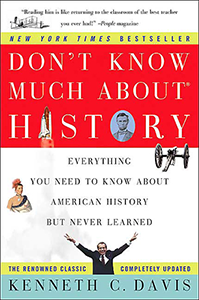
Don’t Know Much About® History: Anniversary Edition (Harper Perennial and Random House Audio)
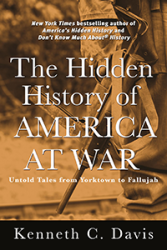
The Hidden History of America At War-May 5, 2015 (Hachette Books/Random House Audio)
July 20, 2015
Who Said It? (7/20/15)
President Franklin D Roosevelt, Speech to the Democratic National Convention, accepting the nomination for a fourth term (Chicago, July 20, 1944)
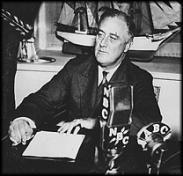
It is good that we are all getting that broader vision. For we shall need it after the war. The isolationists and the ostriches who plagued our thinking before Pearl Harbor are becoming slowly extinct. The American people now know that all Nations of the world- large and small- will have to play their appropriate part in keeping the peace by force, and in deciding peacefully the disputes which might lead to war.
We all know how truly the world has become one- that if Germany and Japan, for example, were to come through this war with their philosophies established and their armies intact, our own grandchildren would again have to be fighting in their day for their liberties and their lives.
Source and Complete Text: Franklin D. Roosevelt: “Address to the Democratic National Convention in Chicago.,” July 20, 1944. Online by Gerhard Peters and John T. Woolley, The American Presidency Project.
Franklin D. Roosevelt made this address in Chicago after accepting the nomination for a unprecedented fourth term in office, which he won in November 1944.
Read more about Roosevelt, his administration and World War II in Don’t Know Much About History, Don’t Know Much About the American Presidents, and THE HIDDEN HISTORY OF AMERICA AT WAR.

The Hidden History of America At War-May 5, 2015 (Hachette Books/Random House Audio

Don’t Know Much About® the American Presidents (Hachette Paperback)

Don’t Know Much About History (Revised, Expanded and Updated Edition)
July 14, 2015
Don’t Know Much About® the “Trinity” Test
A spacecraft the size of a grand piano –launched in 2006– sent back a sort of selfie from space of Pluto –from a distance of 3 billion miles.

The latest color image of Pluto shows a bright, heart-shaped terrain. NASA/Johns Hopkins Applied Physics Laboratory/Southwest Research Institute
This was an astonishing technological feat extending the human desire to know and explore to the edges of the solar system.
But this amazing evidence of humanity’s prowess to understand the universe came just days before the 70th anniversary of the birth of the Atomic Age — the successful detonation of the first atomic bomb on July 16, 1945 in a New Mexico desert at a test site called “Trinity.”
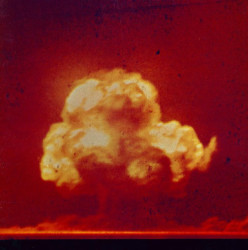
The Trinity Test The photo is courtesy Los Alamos National Laboratories; it is reproduced on the front cover of Los Alamos: Beginning of an Era, 1943-1945 (Los Alamos: Public Relations Office, Los Alamos Scientific Laboratory, ca. 1967-1971).
General Leslie Groves, the military leader of the Manhattan Project –the secret wartime American effort to develop an atomic bomb– wrote a memo describing the test that changed history:
For a brief period there was a lighting effect within a radius of 20 miles equal to several suns in midday; a huge ball of fire was formed which lasted for several seconds. This ball mushroomed and rose to a height of over ten thousand feet before it dimmed. The light from the explosion was seen clearly at Albuquerque, Santa Fe, Silver City, El Paso and other points generally to about 180 miles away. The sound was heard to the same distance in a few instances but generally to about 100 miles.
Groves cited in his memo the words of another general who commented that day:
It was a great new force to be used for good or for evil.
Source: “Memorandum for the Secretary of War” (July 18, 1945) PBS/American Experience: “Truman“
A few days later, President Truman made the fateful decision to drop two atomic bombs on Japan, hoping to force the Japanese to surrender and end the war in the Pacific. That decision, which surely shortened the war, cost hundreds of thousands of Japanese lives and opened the age of atomic warfare capable of destroying humanity. Future posts will discuss Hiroshima and Nagasaki.
The U.S. Department of Energy offers an interactive history of the Manhattan Project, the Trinity Test and the dropping the bombs.
You can read more about dropping of the atomic bombs and the Cold War atomic race in Don’t Know Much About History and The Hidden History of America at War.

Don’t Know Much About® History: Anniversary Edition (Harper Perennial and Random House Audio)

The Hidden History of America At War (Hachette Books Random House Audio)
Friday Pop Quiz: Who was Gerald Ford’s Vice President?
Nelson A. Rockefeller (1908-1979)
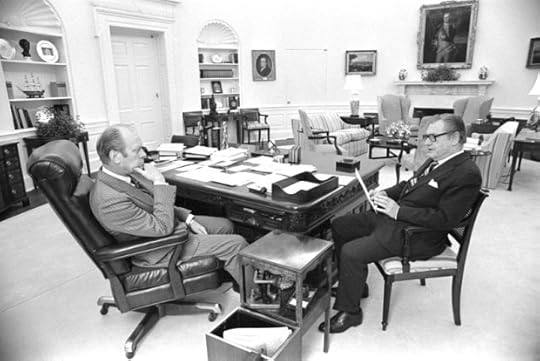
President Gerald Ford and Vice President Nelson Rockefeller Meet in the Oval Office March 12, 1975 (Source: White House; photographer Ricardo Thomas)
With the resignation of Richard M. Nixon on August 9, 1974, Vice President Gerald Ford became President. He then nominated Rockefeller, the former governor of New York to become his vice president under the terms of the 25th Amendment, ratified in 1967 to deal with issues of presidential succession and disability.
Before ratification of the 25th Amendment, there was no constitutional mechanism for replacing a vice president who either became president or died in office. Section 2 of the Amendment reads:
Whenever there is a vacancy in the office of the Vice President, the President shall nominate a Vice President who shall take office upon confirmation by a majority vote of both Houses of Congress.
When Spiro Agnew resigned as Nixon’s vice president in 1973, Ford became the first man to become vice president under this amendment. When Ford replaced Nixon as president, Rockefeller became the second.
I’ve known all the Vice Presidents since Henry Wallace. They were all frustrated, and some were pretty bitter.
—Nelson Rockefeller
(Source: U.S. Senate)
Elected to four terms as Governor of New York, Rockefeller was born into the family whose wealth came from John D. Rockefeller, founder of the Standard Oil Company and once America’s wealthiest man. For many years, Rockefeller was among the most powerful Republican leaders and a contender for the presidency. He had also been considered for the vice presidency several times.
Nelson Rockefeller died early in 1979 in headline-making fashion:
“On Sunday, January 27, 1979, New Yorkers awoke to the news that Nelson Rockefeller had died of a heart attack at the age of 71 while working at his office in mid-town Manhattan. In the days ahead, as dignitaries and associates sang his praises, the actual circumstances of Rockefeller’s death began to emerge: he had died in his townhouse while in the company of a young female staff assistant 45 years his junior. Her delay in calling the paramedics stirred endless speculation, leaving many questions unanswered.”
Source: American Experience (PBS) “The Rockefellers”



